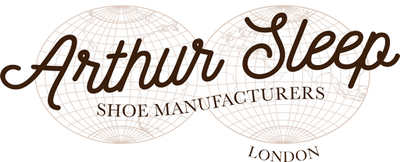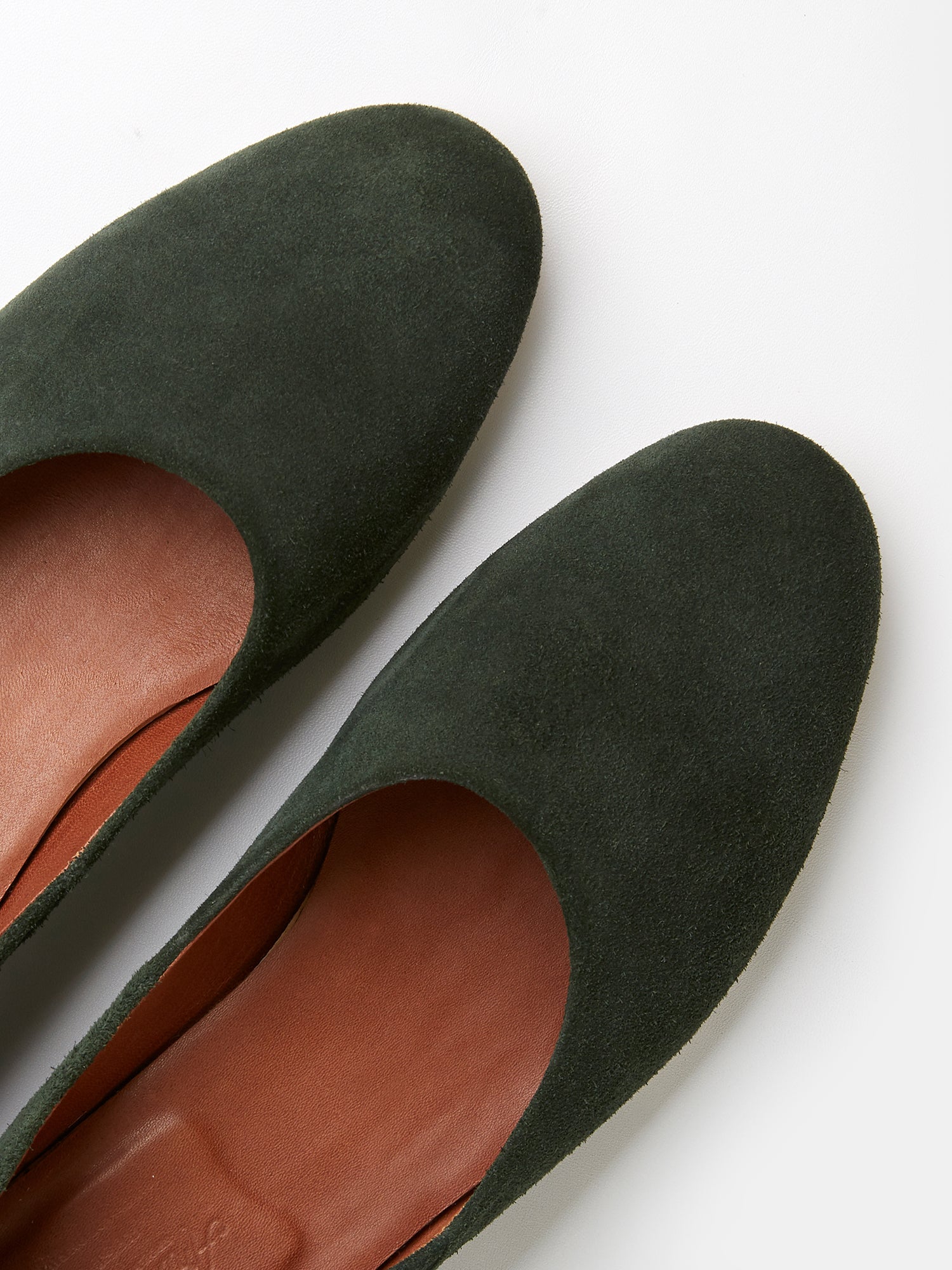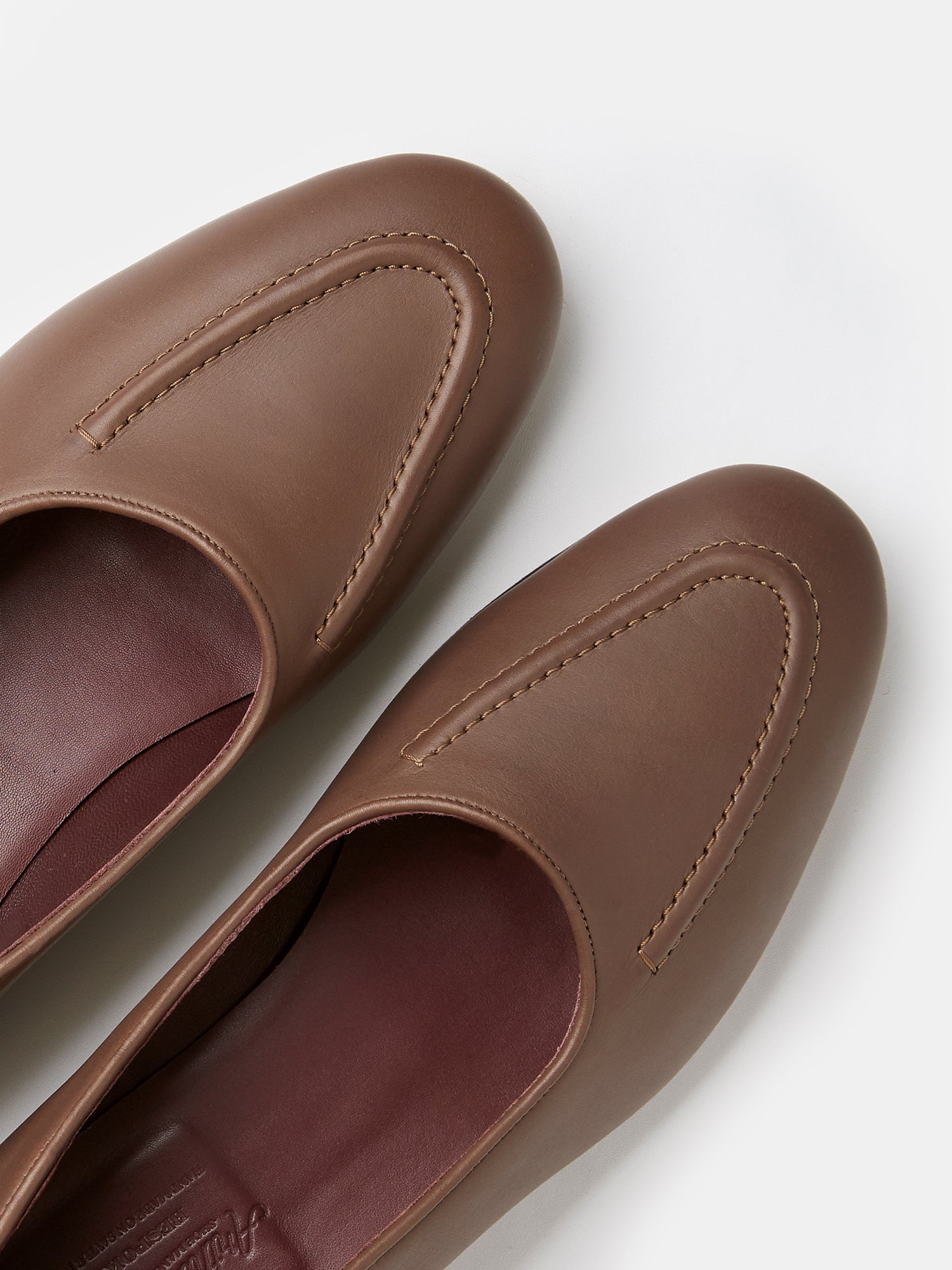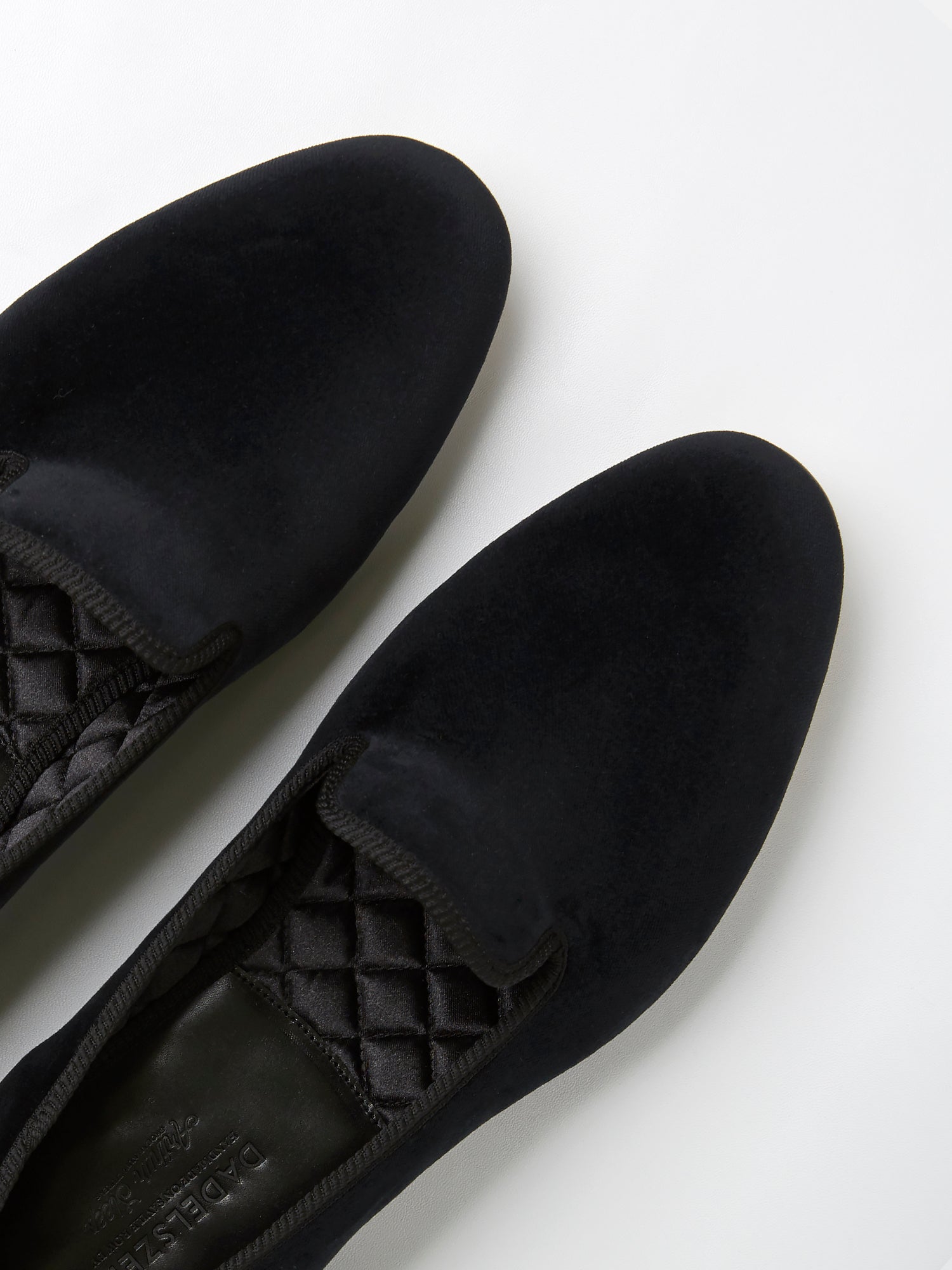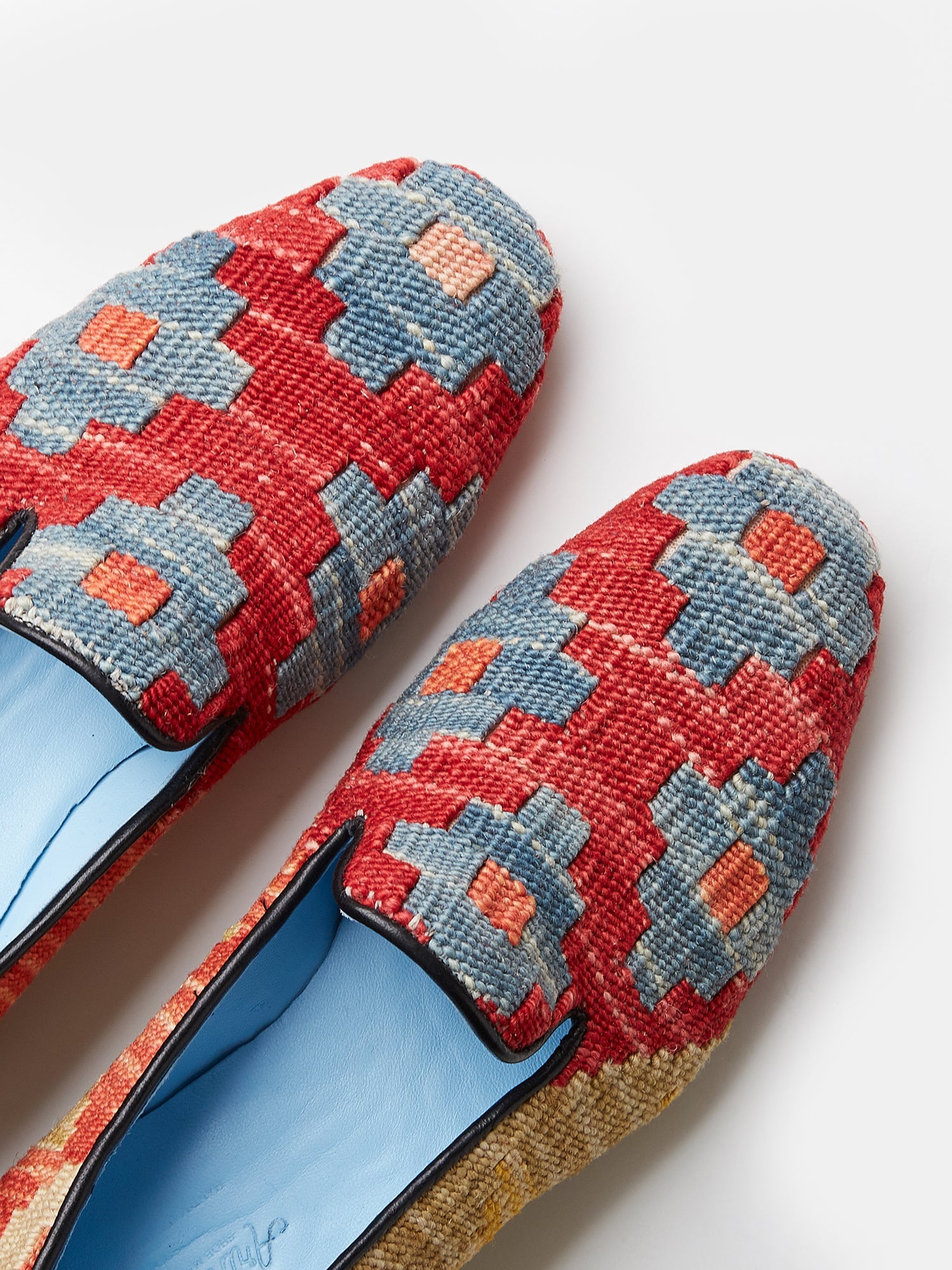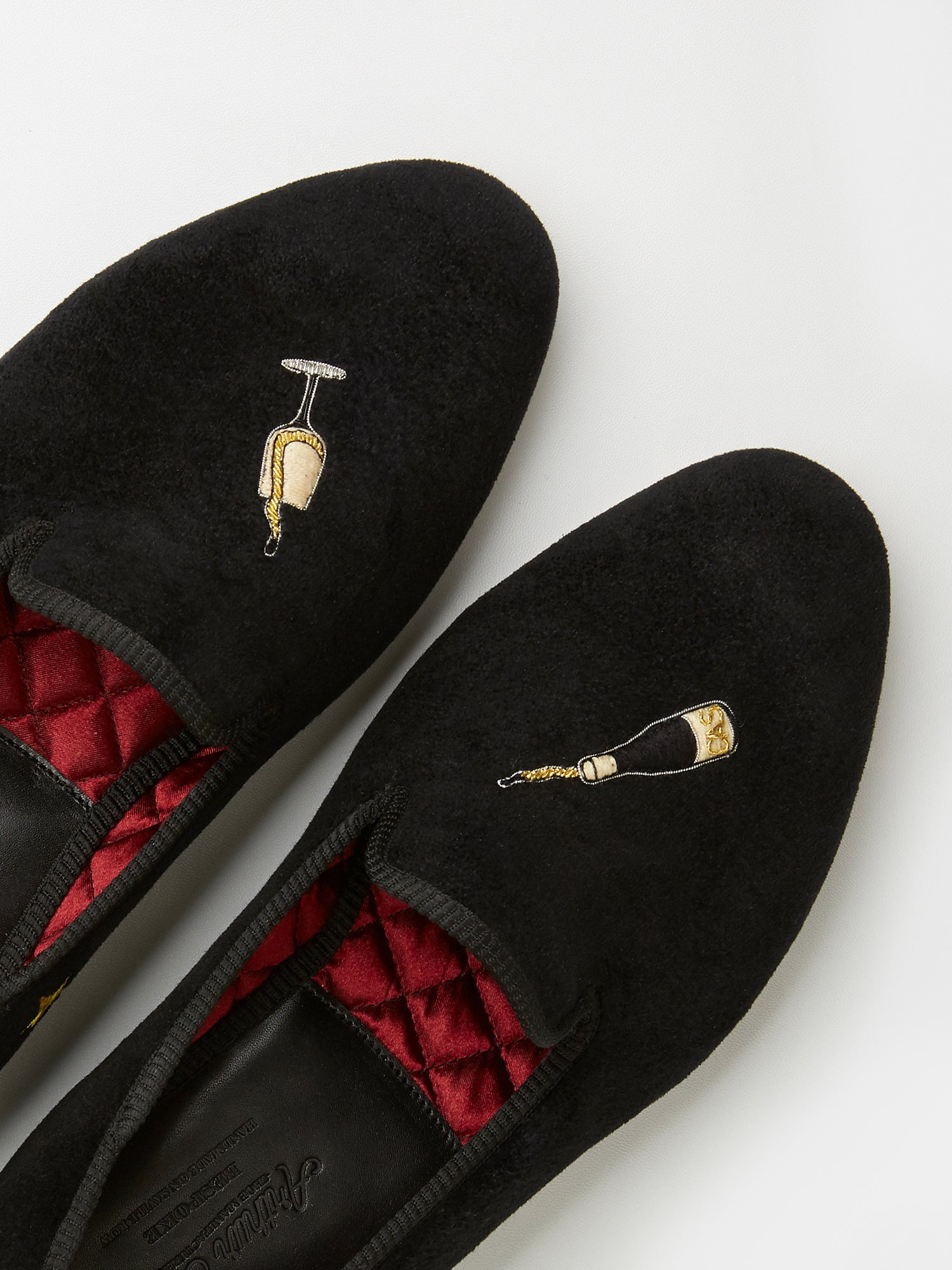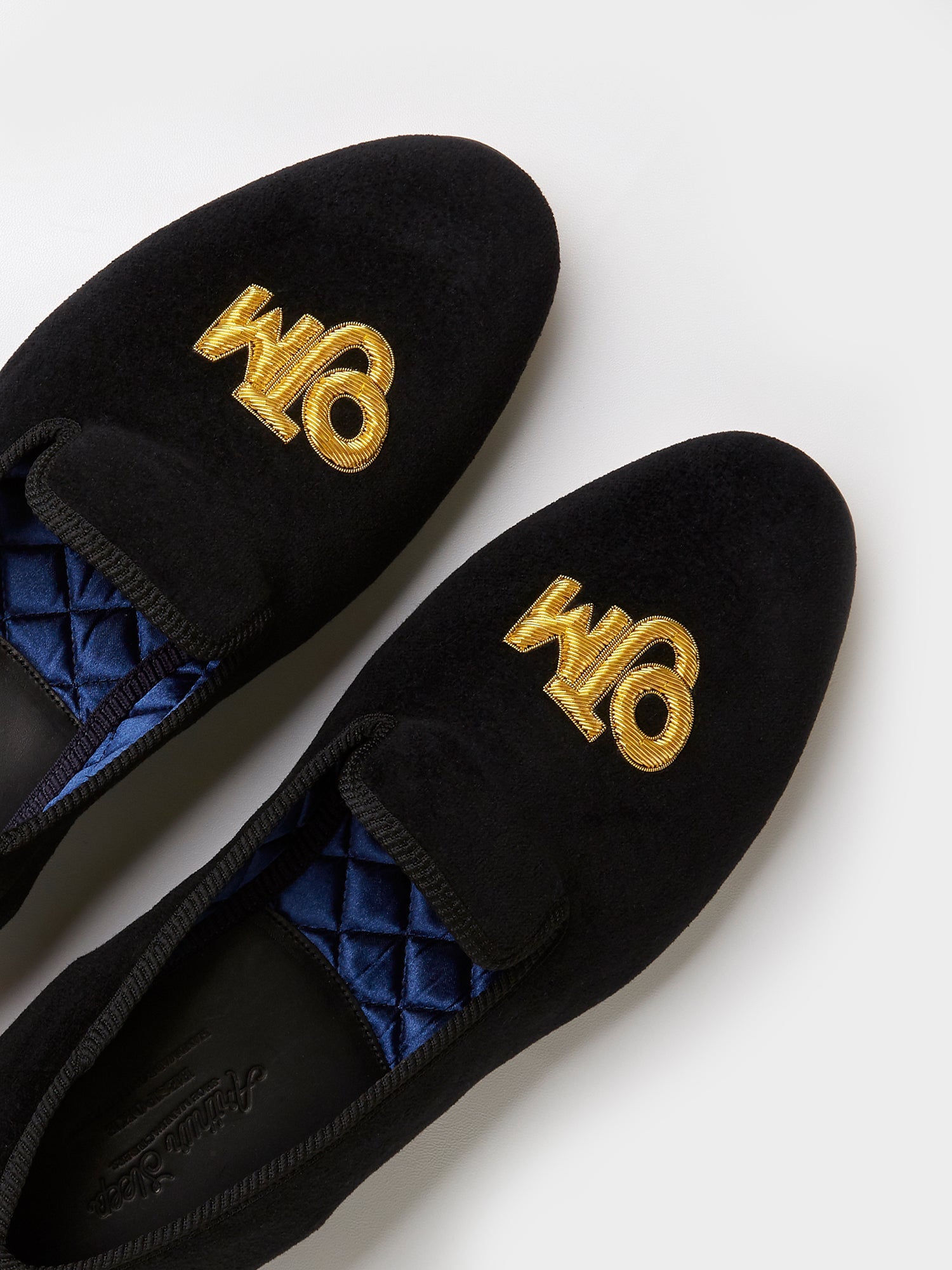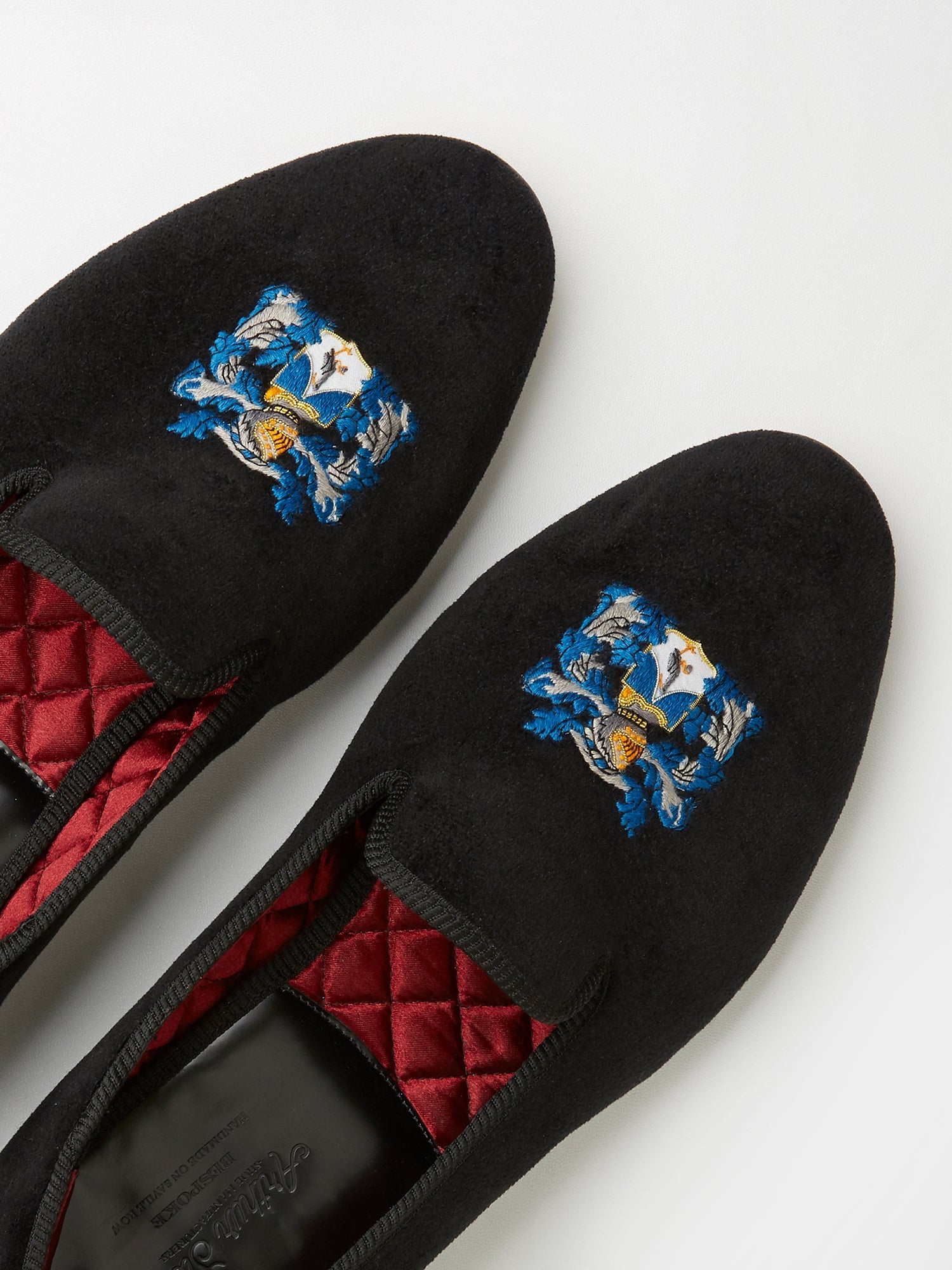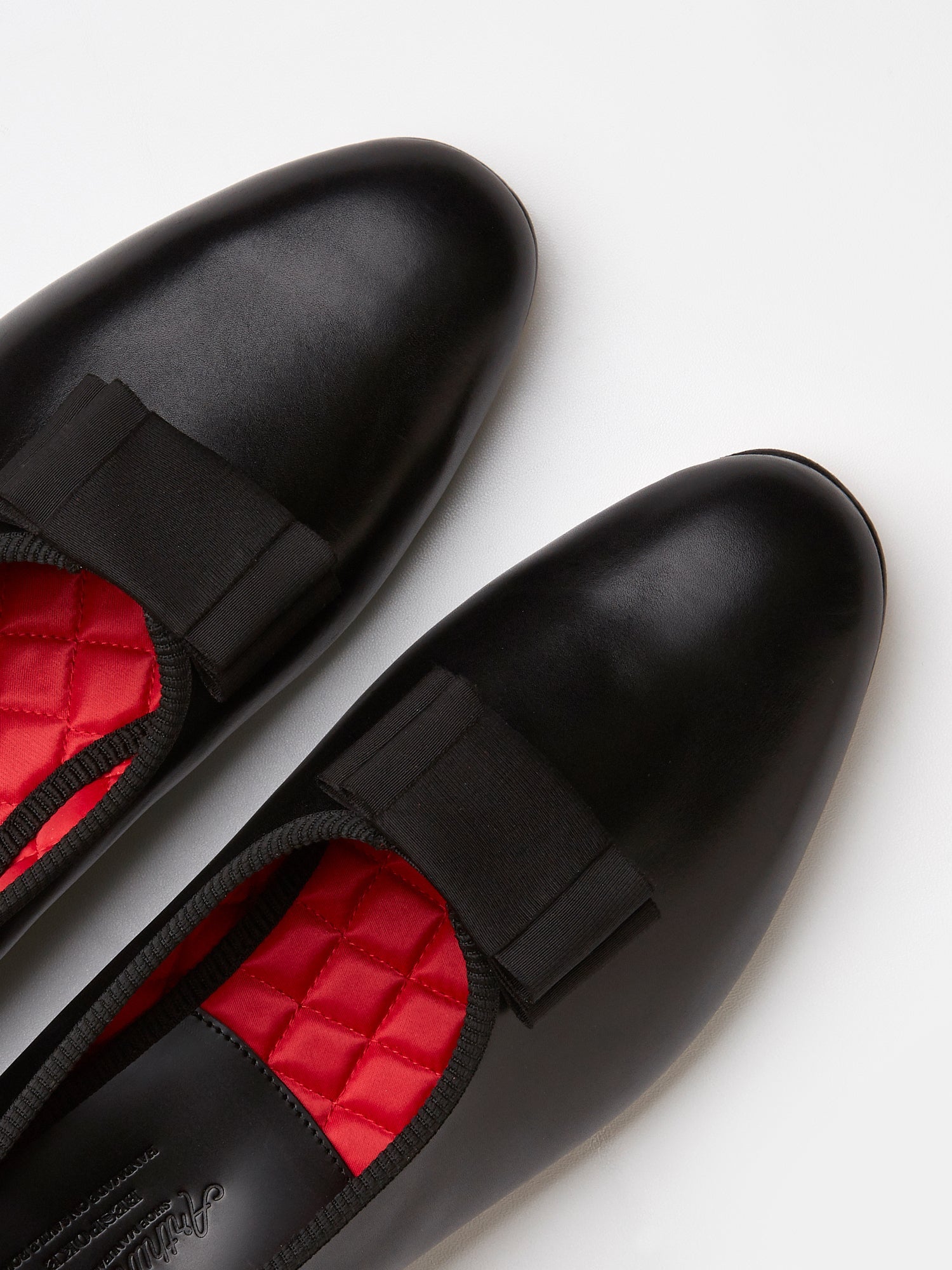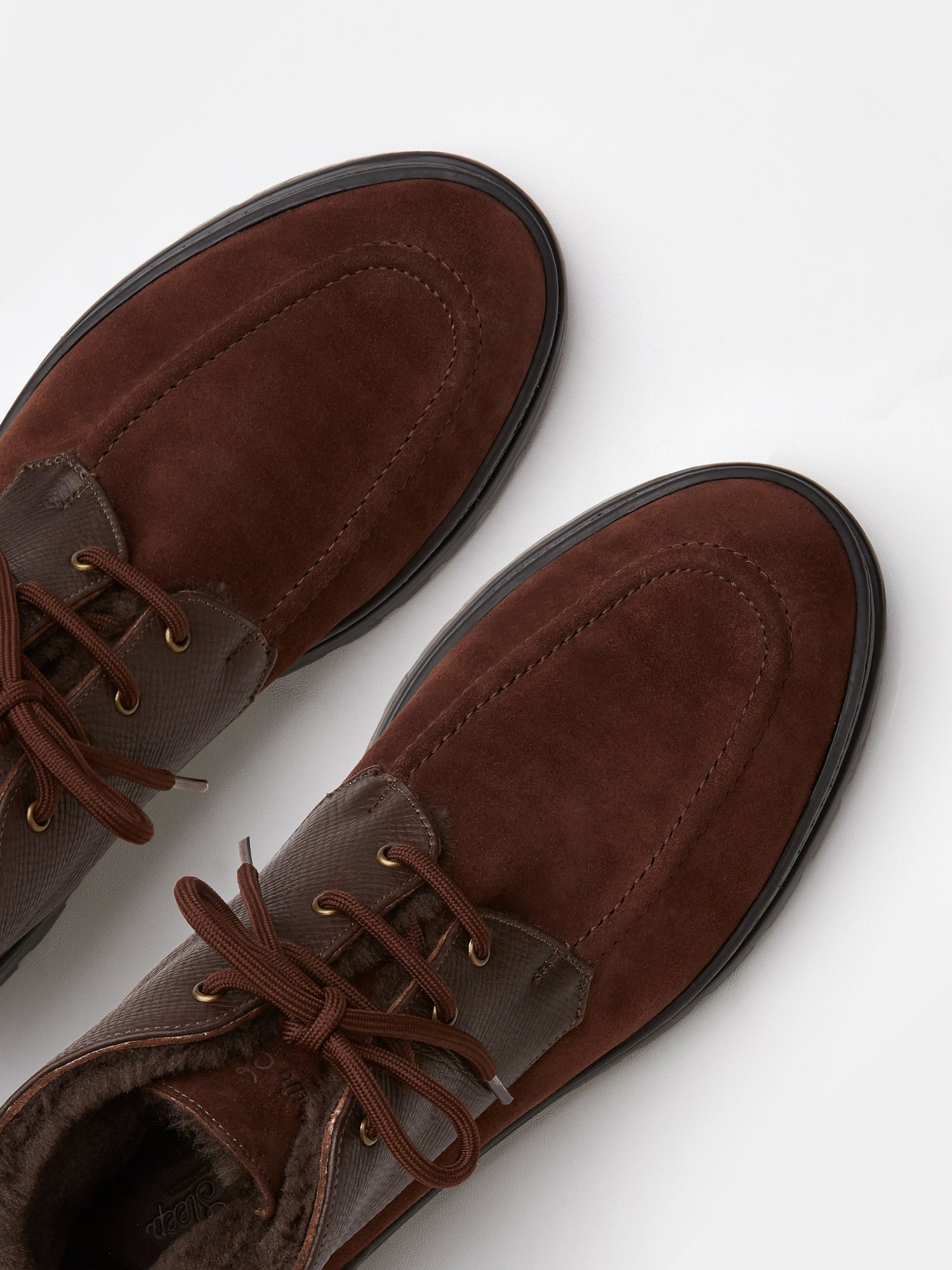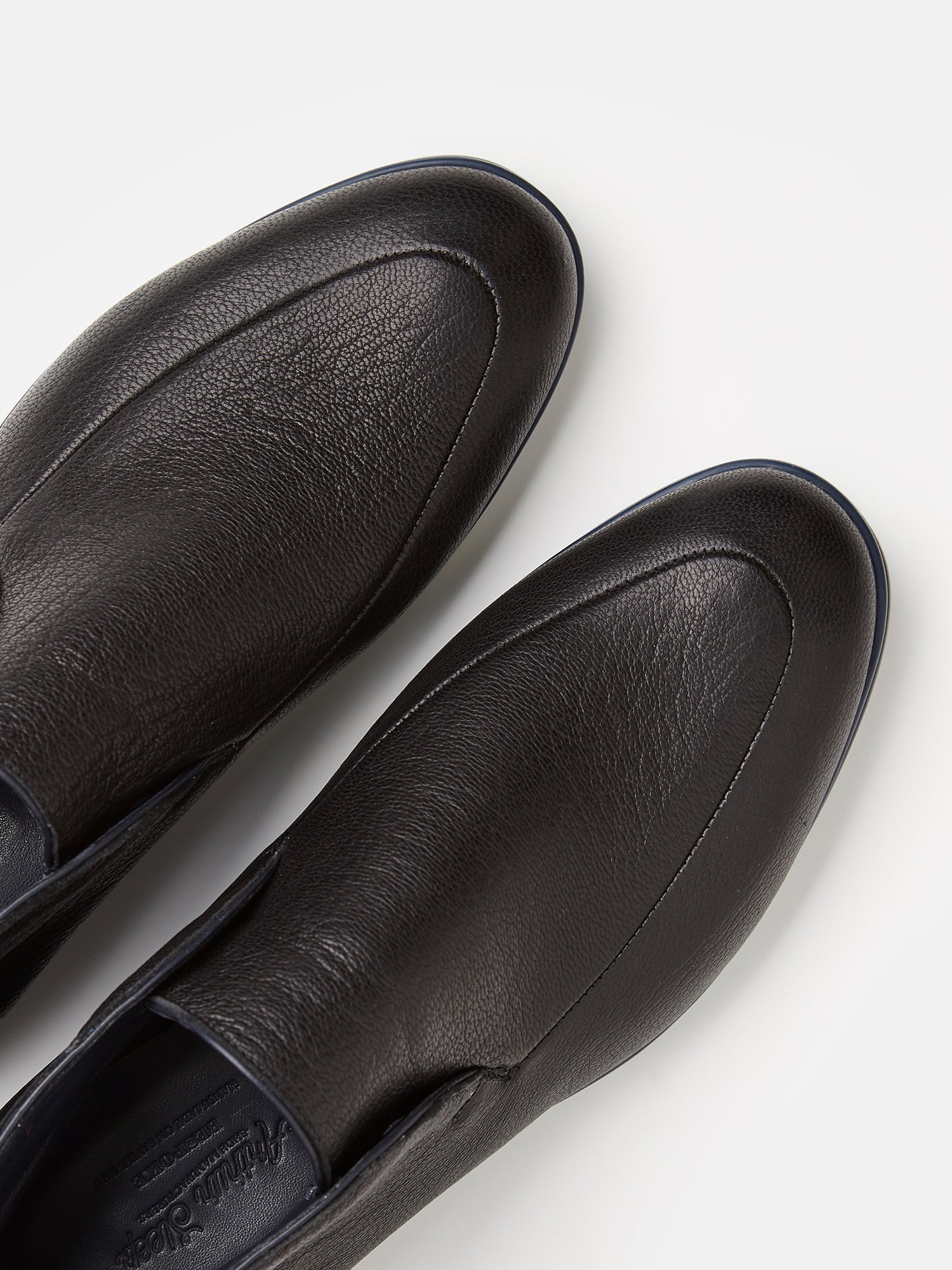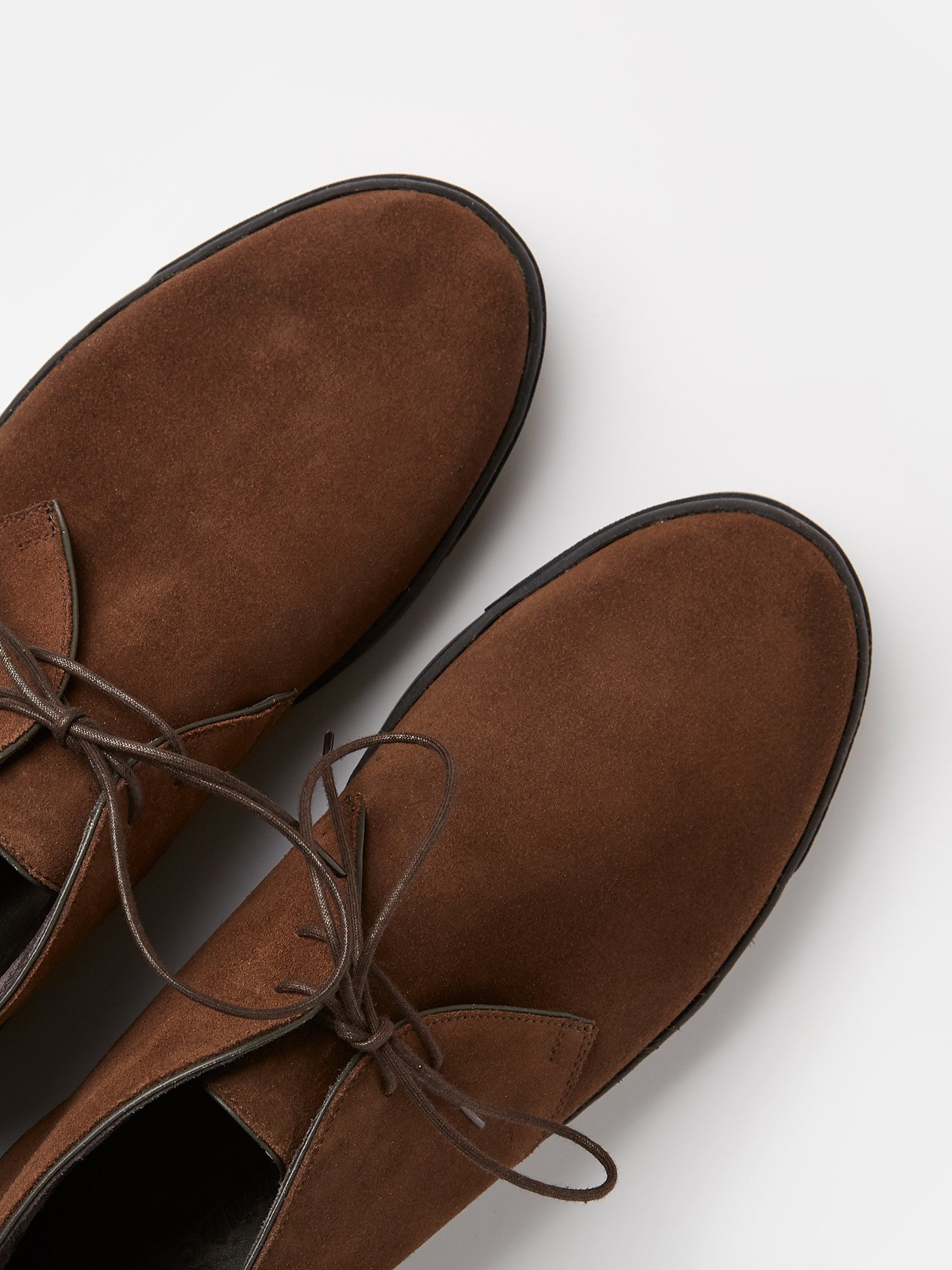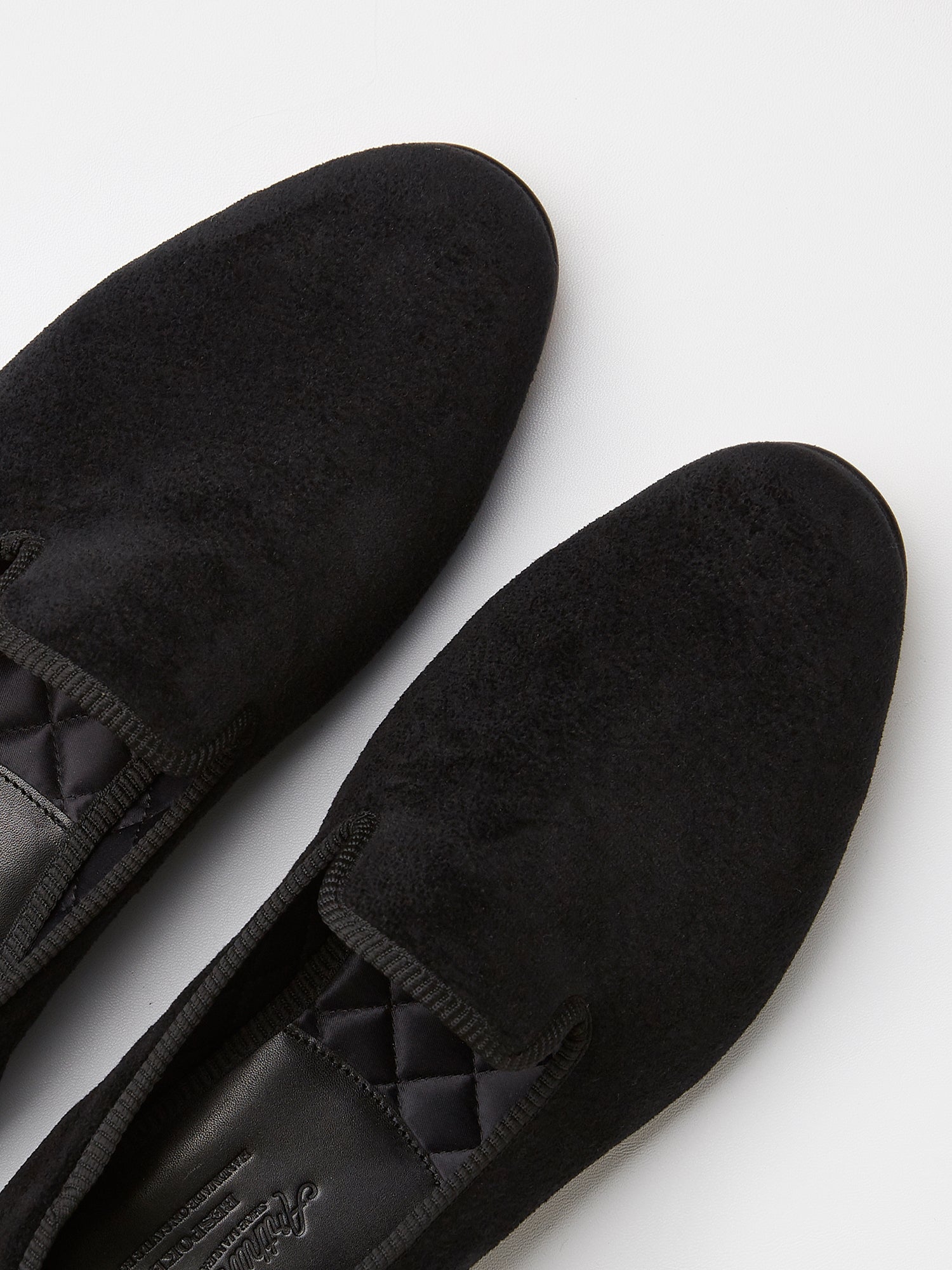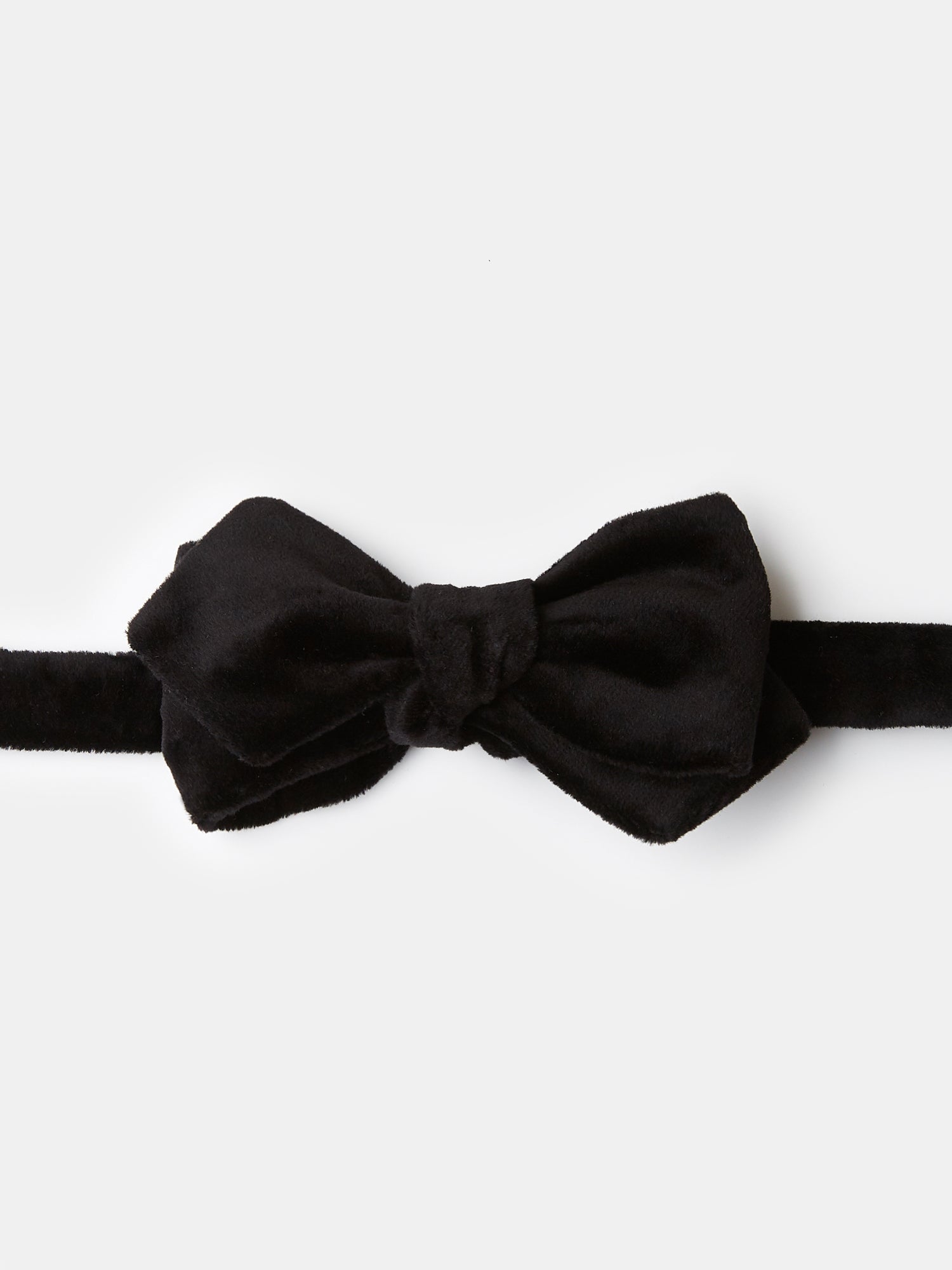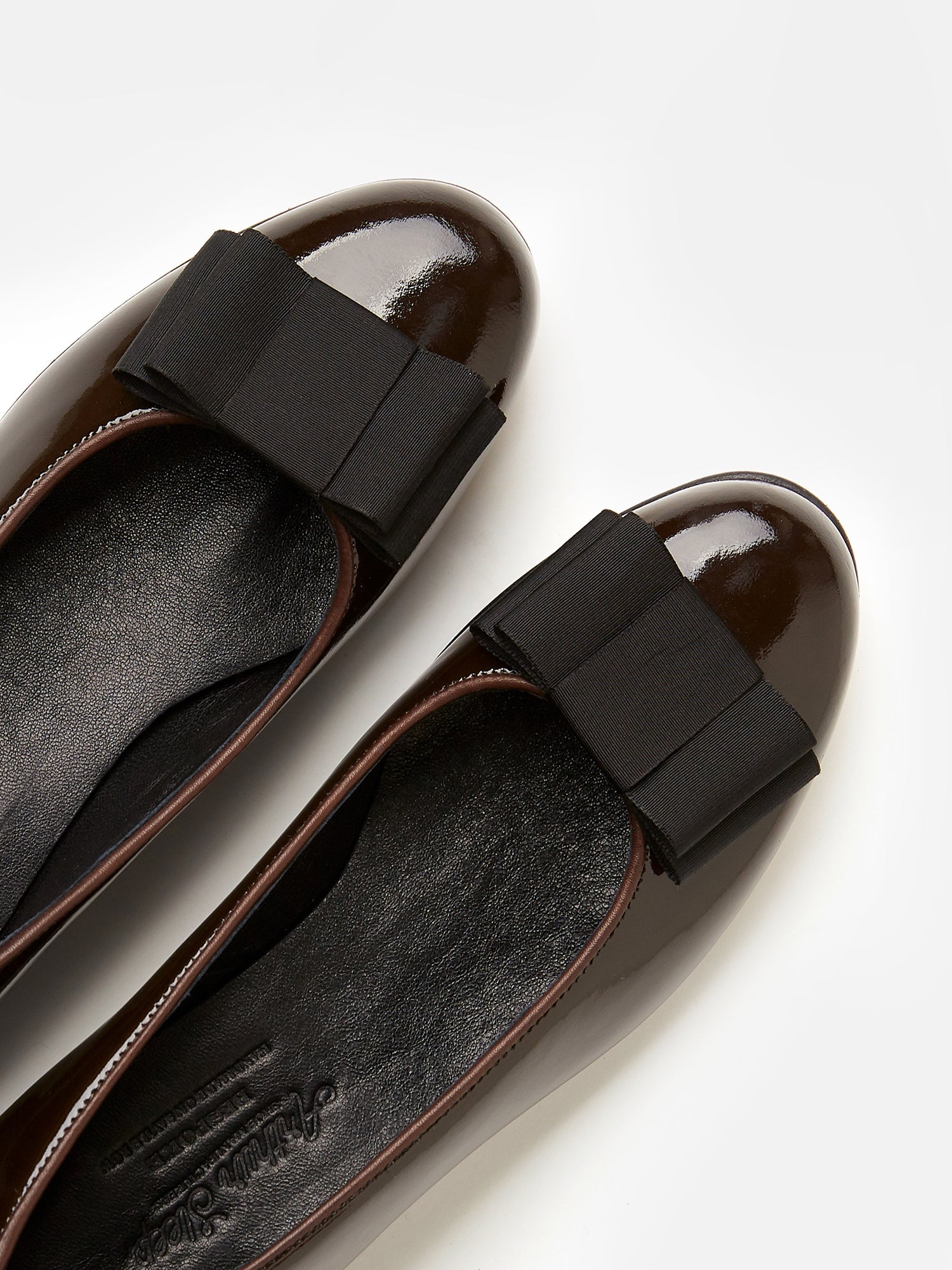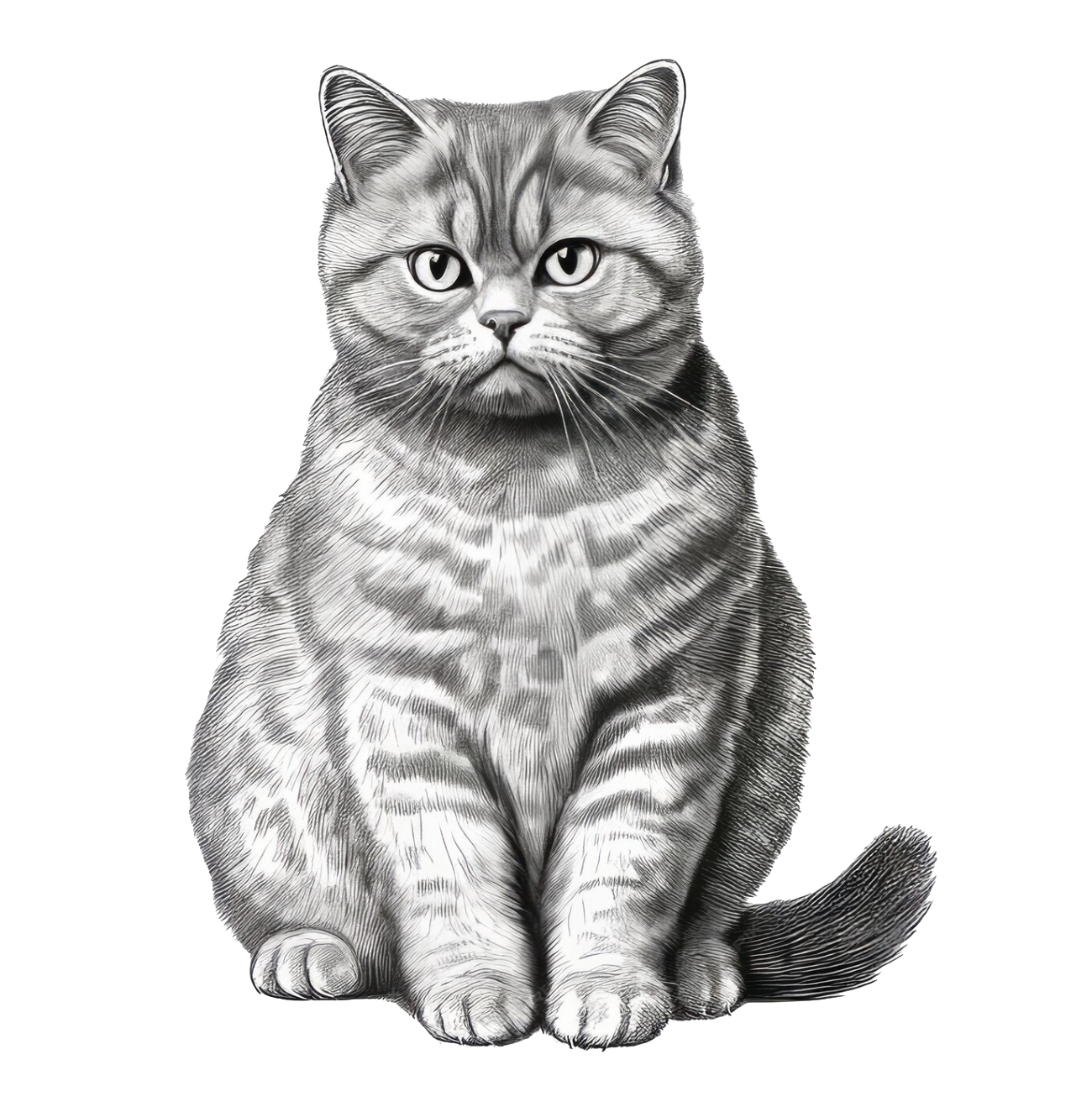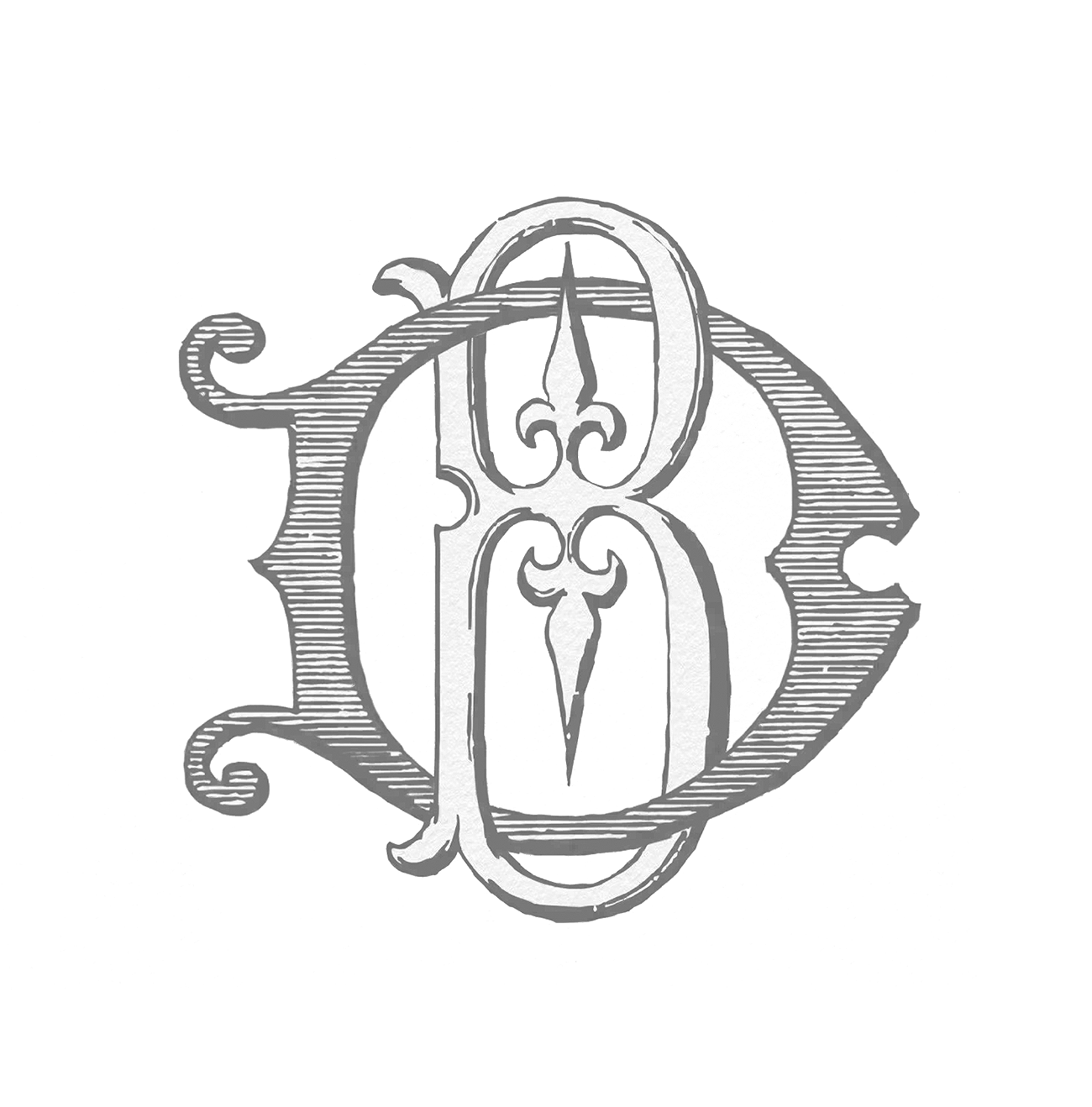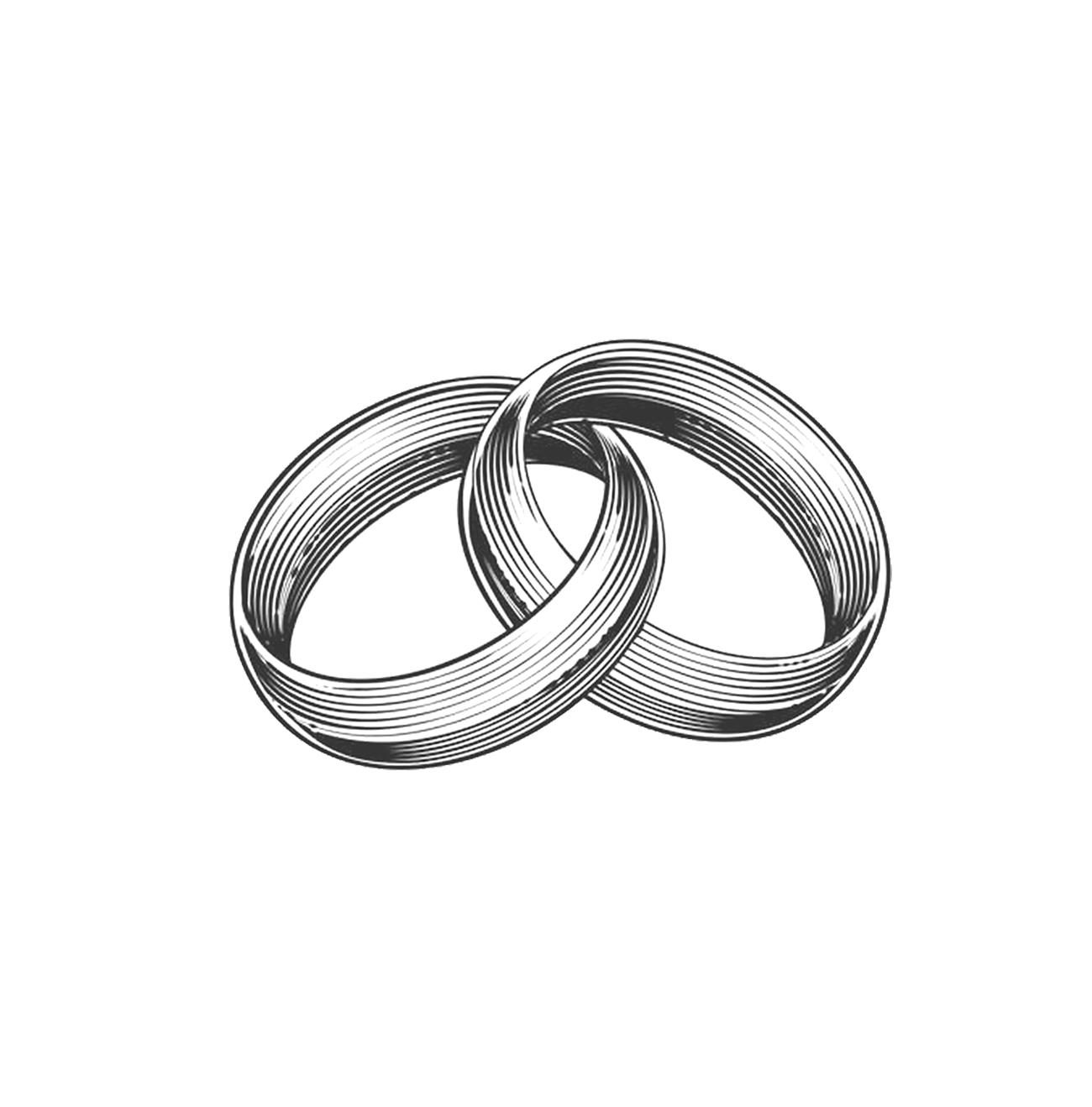Glossary of Shoemaking Terms
12 Key Shoe Terms
- Cordwainer: The traditional name for a shoemaker. Derived from cordwain or cordovan, a Spanish leather originally used for shoes, which came from Cordoba, Spain.
- Oxford: A classic closed, lace-up shoe, where the eyelet tabs are stitched under the vamp.
- Brogue: A type of classic lace-up shoe with perforated and pinked leather decorations.
- Derby: Classic front-laced shoes with open eyelet tabs stitched over the vamp.
- Slipper: A light shoe which can be easily slipped on and off, often made from fabrics such as velvet, wool or silk.
- Last: A shape over which the upper is moulded. Bespoke shoes use lasts carved to the shape of the customers feet, and ready-made shoes use standard lasts made for each style of shoe.
- Quarters: The sides of the upper which join the vamp at the front and are seamed together at the back. They are so called because in a pair of shoes there are four of them.
- Upper: The portion of a shoe or boot that covers the top of the foot. Depending on the shoe type and style, it can consist of the toe cap, vamp, tongue, quarters and back.
- Vamp: The front part of the upper covering the toes and part of the instep.
- Shank: A reinforcement placed at the waist of a shoe and between sole and insole.
- Insole: The sole to which the upper is attached, and on which the foot rests. The outside sole is added underneath.
- Sole: The under surface of a shoe or boot, which rests on the ground.
Glossary of Shoemaking and Shoe Part Terms
Addition method: A method of fitting up the custom made last. If the foot is broader, the instep or big toe higher, or the heel thicker than the average, the shoemaker currents the last by attaching various pieces of leather to it. Though the shoemaker can use this correct last to make a shoe, it is advisable to produce a definitive last by fine copying it.
Apron front: A shoe front having a shield-shaped ‘apron’, either underlying or overlaying the vamp, marked with visible stitching. The style derives from the moccasin, in which the apron sometimes forms the top part of the upper.
Arch supports: At an early stage, fallen arches can be counteracted with supports. This is why it is important for the shoemaker to form a precise idea of the state of the arches.
Artois buckle: A shoe buckle of large proportions, popular in the 1770s and 1780s.
Awl: The shoemaker uses a long awl to make holes in the welt for the stitches and a short one to make the holes for the wooden pegs in the rand.
Awl holes: Square holes made with the awl for the wooden pegs used to attach the rand. The hotels are eventually sealed with adhesive.
Back stiffener: A leather reinforcement inside the shoe at the point where the quarters meet.
Back strap: A strip covering the seam joining the quarters at the back of the shoe or boot.
Basic forme: Used to produce the design for the upper. The designer transfers the design from the last onto the paper.
Bead: A strap of material interested into an upper seam for reinforcement. Also known as welt when referring to a sole seam insert.
Blake welting: A type of stitched shoe construction where the upper is sewn directly to the sole from the inside of the shoe. Although not as water resistant, a Blake stitch offers more flexibility to the shoe itself. Because it is a simpler construction than a goodyear welt, it tends to be less expensive. The Blake stitching machine was invented in 1856, and is common in Italian shoes.
Breast: The front surface of the heel, usually termed heel breast.
Breasting iron: A tool with different cross-section sizes used by the shoemaker to smooth the edges of the sole and heel and make the material more dense.
Brogueing tow: An arrangement of holes of the same or different sizes at regular intervals along the lines and curves where the upper components meet.
Burnishing iron: Iron tool that the shoemaker heats to the required temperature over a flame and uses to press ink and shoe cream into the leather.
CAD/CAM: Computer aided design/ Computer Aided Manufacture. Today most shoe manufacturers create their footwear using CAD/ CAM.
Cap: A separate component of the upper, positioned over the toes. It may be straight, peaked or winged, or a combination of the last two styles.
Chape: The pronged part of a buckle, through which the strap is secured.
Clicker: A craftsperson who cuts out the component parts of the shoe upper.
Clicking: Cutting out of the upper components from the appropriate leather in accordance with the style formes.
Closed tab: An upper pattern in which the eyelet tabs are stitched down to the vamp- for example in an oxford shoe.
Closer: The craftsperson responsible for slinging, shaping and sewing the leather uppers and inner sole around shoe lasts.
Closing: A part of the shoemaking process in which the upper sections are stitched together.
Closing shop: The workshop where the upper components were traditionally reinforced and stitched together. Today uppers are made industrially and supplied to the shoemaker.
Clump or clump sole: A half-sole, usually added to a shoe as a repair.
Cobbler: The term for a repairer of shoes. The industrial revolution forced many shoemakers to become cobblers, as machines took over shoe production.
Cobbler’s hammer: Weighing some 18 ounces (500g) the cobbler’s hammer is similar to a household hammer, and has many uses.
Collar: A thin, rolled strip of leather serving to reinforce and decorate the upper areas of the quarters.
Cordwainer: The traditional name for a shoemaker, derived from cordwain or cordovan, a Spanish leather originally used for shoes, which came from Cordoba, Spain.
Counter: An alternative name for a stiffener, though restricted to ‘outside counter’- a separate component placed over the pack parts of the quarters.
Cuban Heel: A fairly straight-sided heel that is broader at the base than the Spanish heel.
Currying: The process of dressing leather as part of the tanning process.
Custom made shoes: Handmade shoes that fit the feet perfectly. They are manufactured on the basis of the information gathered in the measurement taking process.
Direction of stretch: The direction of stretch of the upper leather is important to the placing of the formes. The forme for the vamp, for example, must be oriented so that the leather can expand lengthwise but not across- whereas if the quarters can expand lengthwise, they will stretch by two-fifths to four-fifths of an inch (1-2cm) and the shoe will lose its shape and fit.
Eyelet: A hole for lacing. However, a convention has developed for using this term only for those holes with metal or plastic binding. Where the binding is visible only on the inside, the term blind eyelet is used. Other holes should be termed lace holes or stitched lace holes. Thomas Rogers first patented a metal eyelet machine in 1823.
Eyelet tab: see facing.
Facing: The front part of the quarters that carries the eyelets, sometimes referred to as eyelet tabs.
Filling: Substance used to fill the gap in a welt stitched shoe, with a shock-absorbing and stabilising effect on the sole when walking.
Fine copying- A last making method in which the measurements of the last forme are precisely transferred to the new last by machine. Also a lastmaking method in which a last that has been corrected by the addition method functions as a last forme.
Finishing: The final process underdone by the shoe once it’s construction is complete, consisting of washing, creaming, and polishing the upper; and inking, heelballing and polishing the edges of the sole and the heel. The edge of the sole is pressed with the edge iron and the edges of the heel smoothed with the dummy iron, and both are then individually patterned with the fancy wheels. The top piece and sole are creamed or inked.
Finishing wax: Type of wax, of which the shoemaker applies a thin coat to the upper surfaces of the shoe after inking, It is then pressed into the leather together with the ink using a warm iron.
Foot arch: The lengthwise and transverse arch of the foot. It bears the entire body weight when standing and walking. It acts as a shock absorber, reducing the impact on the head and spinal column when walking.
Foot documentation: All the important information about the feet and their owner established in the measurement taking process; the measurement record, the foot imprint, draft drawings, and markets up lasts.
Foot elevation: The side and rear elevation of the foot transferred onto paper.
Foot imprint: An imprint of the food produced by the Ped-a-graph. It gives an exact picture of the arch of the foot, the intersection points of the arch curves, and the position of the toes.
Foot outline: The shoemaker makes an outline of the food with a vertically held pencil on a sheet of paper, from which the length and width of the shoes are then measured.
Forepart: The front of the shoe (or sole or insole).
Foxing: American term for the leather parts forming or covering the vamp or back part of a wool serge gaiter boot.
Flesh side: The side of the skin joined to the animal. Since the eighteenth century this has been used for rougher and more workaday footwear as scuffs and scratches show less.
Gimping: Trimming and simultaneously decorating the edges of leather pieces. The shoemaker shoes this with a gimping machine in which steel tools with various patterns and designs can be fitted.
Girths: Characteristic measurements for the individual foot. The girth is measured at the metatarsals, the instep, the heel and the ankle.
Goodyear Welting: A type of stitched construction where a leather welt is attached to the insole by machine, and the sole is then stitched to the welt. This allows the shoes to be easily re-soled. The Goodyear welting process was invented in 1896 by Charles Goodyear Jr, son of the American engineer Charles Goodyear.
Grain: The outer surface of a piece of leather originally bearing the animal's hair, fur or wool. Each animal has a characteristic grain pattern and the surface is usually smooth. Soles tend to have a gain side downwards resting on the ground, while insoles usually have the grain side upwards. Uppers normally have the grain side outwards, except in the case of suede. Since the eighteenth century, this has been used for better-quality footwear.
Half sole: A short sole under the forepart, not reaching to the heel. Usually a repair- either replacing the worn forepart sole cut away or added as a clump.
Heel: A solid base under the back of the foot, usually a wooden shape covered in leather or fabric, or built up with layers of leather. In either case the part of the heel that rests on the ground is called the top piece.
Heel Breast: The front surface of the heel, facing the arch of the foot.
Heel construction: Several leather lifts, a top piece, and a quarter rubber are assembled to form the heel.
Heel cup: A piece of leather (part of the upper) on the outside of the back of the shoe covering the seam joining the quarters. It may be a narrow strop or a long, vertical piece of leather in line with the heel.
Heel Edge: The outer surface of the heel, usually it is black, but sometimes it is coloured to match the upper leather. If it is not coloured, the individual lists are readily discernible.
Heel grip: A small strip of leather or suede inside the lack of a shoe to help the she stay on the foot.
Heel lifts: Two to four pieces of leather cut to the shape of the heel, which they jointly form.
Heel section: the back of the shoe.
Hobnail: A nail with an enlarged head, usually domed, and used for sole protection.
Hose: A textile leg and foot covering.
Inner sock: Leather lining in fittest contact with the foot. The customer can specify that it should cover the whole of the insole, three quarters of it, or only a quarter (under the heel). Also see Sock.
Insole: The sole to which the upper is attached, and on which the foot rests. The outside sole is added underneath.
Instep: The raised area on the top of the foot above the toes.
Lace: Lengths of leather, silk ribbon or braided cotton, used through holes, to fasten footwear.
Lacing: Horizontal lacing, characteristic of the oxford, is more elegant, while crossover lacing is more casual, characteristic of the Derby. It can be carried individually, however.
Lacing hooks: Hooks formed from narrow strips of metal, with rounded ends, for boot laces to be wound around, instead of threaded through eyelets, on the latchets. They were first patented in 1865.
Last: A shape over which the upper is moulded. Bespoke shoes use lasts carved to the shape of the customers feet, and ready-made shoes use standard lasts made for each style of shoe.
Laster: The craftsperson who manipulated the stitched upper over the last.
Last removal: The removal of the last from the completed shoe. The shoemaker carefully pulls it out using the foot strap and an iron hook about a quarter inch (6-7mm) thick, adjusting the pressure with the foot strap.
Last type: This determines the shape of the shoe. The differences lie in the shape and width of the vamp. It is the responsibility of the shoemaker to obtain the right type of last for his client.
Lasting: Nailing the upper to the insole on the last. The last now gives the upper a plastic form.
Latchets: The part of the upper over the instep with eyelets for closing with shoelaces, usually over a tongue, and formed by extensions of the quarters. Sometimes called lacing tabs or eyelet tabs.
Leg: The part of a boot which covers the ankle and above.
Lining: The interior part of an upper, usually divided into the same sections as the outer-that is, vamp lining, quarter lining and leg lining.
Lining leather: Vegetable-tanned leather on average one-twentieth of an inch (1.2mm) thick, used to line the inside of the shoe. Though especially soft, it is also hard wearing.
Louis heel: A heel of which the front surface (the breast) is covered by downward extensions of the sole. It swerves inwards sharply at the back and is flared at the base.
Mark: A cut made in the top sole for the top-sole seam.
Measurement taking: The recording of the most important data relating to the foot in order to draw up the necessary foot documentation. It should take place at a time when the foot are in an ideal state. The measurement-taking process has a ceremonial character.
Middle sole: A sole between the welt and the top sole. Characteristic of double-soled shoes.
Middle-sole seam: The seam holding the welt and the middle sole together.
Open tab: An upper pattern in which the eyelet tabs are left unattached to the centre front vamp, as in a Derby.
Paste: A mixture prepared by combining wheat starch, pieces of dried chestnut or potato and water. It has a stiffening as well as a strengthening effect.
Patina: Patina is the natural ageing, oxidising and absorption of oils of leather that allows it to take on a rich colour and a soft sheen over time.
Peg: A strip of wood used for crude heel repairs. Pegs were oval in section for use on early heels. In the nineteenth century, pegs were also used for sole attachment and were usually diamond shaped.
Pinchbeck: A copper alloy that simulates gold.
Pinking: The saw-toothed leather edge that is commonly seen as decoration on brogues. Also a term used during the sixteenth century for creating zig-zag edges and cut-out patterns in leather. The twentieth century term ‘gimping’ is also used to describe zig-zags on brogues.
Polisher: The craftsperson who finishes a shoe, trimming the sole, staining its edge and polishing the leather.
Putting-on brushes: Brushes made of soft horsehair, used to apply shoe cream; it is advisable to use a separate brush for each colour.
Quarters: The sides of the upper which join the vamp at the front and are seamed together at the back. They are so called because in a pair of shoes there are four of them.
Quarter rubber: A piece of hard, non-slip rubber a quarter inch (6mm) thick that is nailed to the top piece of the heel.
Quarter tip: a segment let into the top piece at the outside back where the most wear occurs.
Rand: A narrow strip of leather inserted between the upper and the sole, can also be called a welt.
Removal method: A method of fitting up the custom-made last. If the foot is narrower of the instep flatter than the average, the shoemaker removes the excess wood from the last; in other words he takes material away.
Repair service: Any good shoemaking workshop offers its customers a repair service. It is important for t it to be used regularly in order to give the shoes a long life.
Rivet: A metal nail knocked through the sole against an iron, or iron painted last, to turn the top of the nail back on itself and prevent it working loose.
Rough copying: The measurements are roughly transferred from the forme to a block of wood by machine, thus forming the rough last.
Rubber solution: Rubber dissolved in benzene. This sort of adhesive dries within ten to fifteen minutes and remains flexible and resilient when dry.
Sandpaper: Paper with a rough surface, from coarse to fine, used to smooth edges.
Screw stretcher: A device for widening shoe shoe by hand.
Seat or Heel seat: The rear end of the insole or sole on which the heel of the foot rests.
Sewing thread: Cotton or strong linen. Silk is recommended for stitching very delicate upper components together. Sewing thread for the uppers consists of three, four, six or nine strands. The fineness of a thread is a function of its length in metres and its weight in grams. The colour of the thread should be one shade darker than the colour of the upper leather.
Shank: A reinforcement placed at the waist of a shoe and between sole and insole. Its purpose is to prevent the shoe from bending in at the waist, particularly when a heel is used.
Shoe assembly: The working phase of shoe production in which the insole is nailed to the last and attached to the edge of the upper, the welt and the top sole are sewn on and the heel is built.
Shoe-care set: Every owner of handmade shoes should possess a shoe-care set consisting of cleaning brushes, putting-on brushes, creams, cloths, and polishing brushes so he can take proper care of his shoes.
Shoe horn: A guiding implement made of wood, horn or metal that covers and stiffens the back of the shoe while the foot slips into it. Shorter shoe horns are suitable for shoes, longer ones for boots and ankle boots.
Shoemaker's knife: A steel knife with a slightly curved blade, used for cutting out the lower parts of the shoe (sole, heel lifts) a quarter to a third of an inch (6-8mm) thick.
Shoemaker’s tape measure: A nonelastic textile strip calibrated in French stitches on one side and metric units on the other.
Shoe trees: Pieces of wood shaped like a last, designed to keep the shoes in shape. The two most frequent and popular designs are the three-piece shoe tree and the sprung shoe tree.
Side linings: Narrow pieces of leather cut from the same hide as the upper leather and placed between the upper and lining leathers and between the toe cap and the heel cup to stop the leather stretching and to strengthen both sides of the shoe.
Size: A number indicating the length of the shoe. Various measuring systems are in use: French, English, American and Metric.
Skiver: A small, sharp plane with a guide channel in it used to remove any protruding surface of leather, fraction by fraction, and to match up the edges of sole and heel.
Skiving: The term used for reducing the edge of leather to make it thinner for seams.
Specification sheet: A written form that communicated the designers exact measurement and design details to a shoe factory for mass production.
Sock: A piece of fabric or leather covering the insole inside the shoe. A heel sock covers only the heel end of the insole. Its purpose is to cover nail points or stitches, and it may also carry the maker's name.
Sole: The part of the shoe that is in contact with the ground. If the shoe has a separate heel the part of the heel that is in contact with the ground is called the top piece.
Sole edge: The edge of the welt and the top sole or of the welt, middle sole, and top soled.
Soling: The process of sticking and sewing the top cole cut out of bend leather to the welt.
Spanish heel: A heel in which a single lift is inserted between the sole and the upper.
Spring heel: A heel in which a single lift is inserted between the sole and the upper.
Spur leather: A butterfly-shaped piece of hide leather that is stitched to the front of a boot and to which one could attach a spur to protect the soft leather beneath.
Stacked heel: A heel consisting of a number of lifts (pieces of leather).
Steel plate: Often used instead of a quarter rubber to give a better grip on slippery surfaces.
Stiffeners: A reinforcement placed inside the back of the quarters.
Stitching-channel flap: The leather edge formed when material is pared away from the mark. It covers the top-sole seam, which would otherwise make contact with the ground and quickly gets worn away, sooner or later leading to the separation of the sole.
Stretcher: A metal divide for widening the shoe.
Style collection: A collection of shoe styles in the showrooms of the shoemaking workshop.
Style design: A drawing of the shoe to be made, with its decoration, seams, and the shapes of the individual components, on the last itself. This enables the design to be examined in three dimensions.
Style designer: The style designer, on the basis of classical traditions, designs the shape and decoration of the upper, the proportions of its components, various colours and materials, and creates new combinations. He constantly attempts to add new elements to the classical traditions.
Style form: A form for the upper components. It highlights where the components meet, their relative size, and all lines, curves and decorations. It is used to make individual forms for the upper components.
Tab: An extension of the vamp over the instep, like a tongue. Lacing tabs are an alternative term for latchets.
Tag: The metal or plastic piece on the end of a shoelace, to prevent it from fraying and make it easier to thread through eyelets.
Taking-off brushes: Brushes for polishing, made of the tail or mane hair of the horse. A separate brush should be used for each colour.
Tanning pits (pit tanning): Lined oak or cement pits for vegetable tanning. Layers of skins are placed in the pit- alternating with plant extracts- submerged in tanning liquor,and left to soften for a certain period of time.
Toe cap: Internal: leather stiffener at the top of the shoe. It is used in shoes with a one-piece upper, in which case it is not immediately apparent whether the shoe was made with or without a toe cap. If the vamp is divided, the shoe cap can have a straight (semi-brogue) or winged (full-brogue) shape.
External: That part of the upper that corresponds in shape to the internal toe cap.
Throat: The centre of the front edge of the vamp resting on the instep.
Toe-cap: A separate section over the toe of a shoe, joined to the vamp. A winged toe-cap has the sides extended backwards towards the heel, a peaked toe-cap has the centre extended in a point towards the instep.
Tongue: A leather flap attached to the inside or outside of the upper to protect the lacing area from friction, pressure and penetration by extraneous objects. It also often functions as a decorative component.
Toe puff: A reinforcement beneath the toe end of the vamp.
Top edge: The top of the upper.
Top piece: A shoe is constructed upside down on the last, so the final layer of a heel is put on the top. When the shoe is worn this piece rests on the ground.
Top-sole seam: This seam joins the welt to the top sole (in single-soled shoes) and to the middle and top soles (in double-soled shoes).
Trail shoe: A shoe made in medium-quality leather on the custom made last. If the trail shoe is a poor fit in places, corrections can be made to the last.
Turn welt: A turnshoe that has an extra wide rand included in the seam, which then serves as a welt to which the sole can be attached.
Upper: The portion of a shoe or boot that covers the top of the foot. Depending on the shoe type and style, it can consist of the toe cap, vamp, tongue, quarters and back.
Upper features: Items that either reinforce or decorate the upper: Linen lining, eyelet facing with underlay, collar, lining leather.
Upper reinforcers: Leather or textile stiffeners for those regions of the upper where the danger of stretching is greatest.
Vamp: The front part of the upper covering the toes and part of the instep.
Vamp wings: The size of the vamp that extend backwards either side of the threat to join the quarters of a shoe.
Vulcanization: A method of hardening rubber by heating and chemically combining it with sulphur. This makes it stronger and more elastic.
Waist: The narrowest part of the sole under the arch of the foot.
Wedge heel: A heel that extends under the waist of the shoe to the forepart.
Walled toe: The vamp or toe-cap rises straight up at the toe and turns at a sharp angle to cover the instep.
Welt: A narrow strip of leather sewn around the lasting margin of the upper and joining it either to the insole edge or to a ‘rib’ raised on the flesh side of the insolde, near the edge. The sole is then attached to this welt by a second seam. Welts appear to have developed from the rand and the two names are sometimes confused.
Welt construction: Consists of two layers of soles (insole and outersole) connected to the upper by two seams and a leather wim or welt.
Welt needles: Curved needles just over 3 inches long (8cm). Two of them are needed for the welt-stitching process.
Welt seam: The seam that holds the upper, insole and welt together.
Wheeling: An iron wheeled over the sole seams to seal them; the result is often ridged, but sometimes more fancy patterns are produced.
Width numbering: This system has 5 to 8 girth measurements. Given the shoe size and width number, the girth at the metatarsals, instep, heel and ankle can be calculated.
Wing cap: Heart-shaped shoe cap. The elegant line extends along the vamp almost as far as the heel.
Glossary of Shoe Types
Albert: A man's slipper with a straight top line to the quarters and a vamp that extends upwards to form a tongue resting on the instep.
Albert boot: A side-lacing boot with five buttons and, usually, a cloth top.
Adelaide: A side-laced boot with a leather toe-cap. Names after Queen Adeliaide, wife of Willian IV.
Ankle boots: Footwear for cooler days, with sides reaching 2-4 inches (5-10cm) absolve the ankle bone and fastened with eyelets, hooks, or buttons, their doubled soles give the feet extra protection.
Ballerinas/ Ballet Flats: The ballet flat has a history dating back to 18th century France, but they were first worn outside the dance studio in the 1940s. Italian ballet shoemaker Savatore Capezio developed a streetwear version of his soft ballet shoes for designer Claire McCardell in 1941, and in 1956 another Italian shoemaker, Rose Repetto, created ballet shoe inspired flats for Brigitte Bardot in ‘And God Created Woman’. After their film debut, ballet flats became a popular staple with women across Europe and North America.
Ballet shoes: Either soft ballet slippers, which are worn by sale dancers, children and female dancers off stage, or pointe shoes (also known as toe shoes), which are usually only worn by women. Pointe shoes have a reinforced toe and are usually covered in satin and tied around the ankle with silk ribbons.
Balmoral: A lace-up boot with a galosh, the vamp and quarters cut in one piece with a back seam. Popularised by Queen Victoria who wore them when staying at her Scottish castle, Balmoral. Also a term used in America to refer to an Oxford shoe.
Bar shoe: A Shoe with a low-cut vamp and a strap across the instep, fastened by a button or a buckle. From the early 1900s, closed shoes with a single bar or strap came to be known as Mary Janes.
Barette: A shoe or boot with two or more straps of bars.
Belgian Loafer: Characterised by soft leather and a tear shaped apron on the vamp. Based on a traditional shoe made in Belgium for over 300 years, the Belgian Loafer was popularised by American entrepreneur Henri Bendal in the 1940s. Beloved by New Yorkers in the 1960s, the Belgian Loafer had cemented its status as a classic shoe world wide by the 1980s.
Boots: Usually defined as any kind over covering of the foot that extends above the ankle.
Brogue: A type of lace-up shoe with perforated and pinked leather decorations. A brogued effect can be introduced into styles with fewer sessions by punching and gimping. Examples of this include the ‘London Brogue’ and the ‘Brogued Oxford’.
Brothel creepers: Shoes, usually made of suede, with a thick crépe sole.
Budapest: A well known full brogue Derby style of shoe with a high toe cap.
Bulldog or Boston toe: A bulbous toe shape on both mens and womens shoes, popular in the United States at the end of the nineteenth century and in the United Kingdom in the early twentieth century.
Buskin: A soft leather boot reaching to the calf or knee.
Caliga: An open toed sandal worn by the Romans, usually with a hobnailed sole.
Cambridge: A low-cut slipper with an elastic gusset each side.
Chelsea boot: An ankle boot with elastic sides.
Chopines: Characterised by an extremely raised platform, these shoes were fashionable from the late fifteenth to the early seventeenth century in Spain and Italy. The term derives front the Spanish ‘chapin’ which refers to the cork soled platform characteristic of the Spanish version of the shoe. They are also known as ‘calcagnini’ or ‘piaelle’ in Italy, where they were made with wooden platforms. They were polar until the early seventeenth century, some examples reaching a height of more than 54cm (20 inches).
Clogs: A wooden or wooden-soled shoe, boot or overshoe, including styles of uppers made of leather or other materials, and other shoes that protect the wearer from wet and dirty streets.
Congress: An American term for a boot or shoe with elastic side gussets.
Co-respondent shoe: A shoe of two colours of leather, usually white and tan, popular in the 1920s and 1930s.
Court shoe: A shoe with a low cut vamp, which has no kind of fastening and can be slipped on and off.
Cromwell: A shoe with a high vamp and a tongue or tab, usually with a buckle or some similar trim, on the instep. Inspired by seventeenth-century styles, the name refers to Oliver Cromwell, the parliamentary leader.
Derby: A classic front-laced shoe with open eyelet tabs stitched over the vamp. The womens Derby shoe is often called a Gibson or a Lorne shoe.
D’Orsay shoes: Usually heeled shoes with low-cut vamps and the quarters cut away on the sides, revealing the arch of the foot.
Double-stitched shoe: A handmade shoe with one sole and two stitch rows, or two soles and three stitch rows. All the stitch rows are externally visible. A strong, casual type of shoe. There are two very common variants of the double-stitched shoe: in the first the welt runs from one edge of the heel to the other, in the second the welt also embraces the heel- in which case the heel area is wider than usual. A strong smooth leather is suitable for double-stitched shoes, or one with a rough surface; combinations of different colours are also frequent. Variants covering the ankles are very popular, as are boots.
Duckbills: A modern term for the wide-toed shoes that were fashionable in the first half of the sixteenth century. Some duckbills had small protruding horn shapes at the toes on each side, exaggerating the shape even further. The vamps were usually slashed, revealing the wearer's colourful hose underneath.
‘Eared’ shoe: In the sixteenth century, following a long period of pointed shoes, toes became very square and wide. For a short time (c.1535-1555), the corners of the toes were extended sideways, resembling ears.
Full-Brogue: A type of shoe decorated with perforated patterns, with winged toe caps and rows of perforations.
Gaiters: Cloth or leather coverings for the ankle and leg. They may be buttoned or buckled and sometimes have straps that go under the foot.
Gaiter boots: American side-lacing or elastic sided boot made of wool serge with leather foxing on the vamp.
Glaosh: A shoe construction where the vamp is cut in one piece with the quarter and seamed at the back. Also an overshoe, originally of leather and/or fabric and now usually of rubber.
Ghillie: A shoe of Scottish origin in which the lace passes criss cross through loops in the front of the quarters instead of through eyelets.
Gibson: See Derby.
Golfing shoes: Sports shoes that are often handmade. The top sole is fitted with nine to eleven spikes for increased stability on grass covered ground.
Grecian: A low-heeled or heel-less slipper with a plain front. It is cut away at the sides and has no fastening.
Half-brogue: see Semi-Brogue.
Hand stitched shoe: A shoe made by the traditional method, The two most important types of hand stitched shoe are the welt stitches and the double stitched variants.
Langtry: A shoe similar to the Cromwell, bit with a strap or low bow fastening.
Loafer: Casual slip-on leather or suede shoes with a low stacked heel, essentially a low heeled pump.
Moccasin: A basic type of shoe in which the shoe sole and upper, or part of the upper, are made from one continuous piece. Worn for centuries by native Americans, the shoe's name originates from the Algonquian word for show.
Monk shoes: Characterised by quarters that extend over the tongue, usually fastened with a strap and buckle to the side.
Mule: Backless shoes that leave the heel of the wearer exposed.
Norwegian shoe: A variant of the basic Derby, a controversial, flamboyant, and youthful style characterised by an unusual division of the vamp and hand stitching on the upper. Its rustic character is often accentuated with heavily grained leather.
Opanka: A shoe in which the hard sole and par of the upper are continuous. The name originates from the Serbian for ‘climbing footwear’.
Opera pump: A classic formal shoe made of patent leather with a bow on the vamp and a quilted lining. Originally developed in the 18th century to be worn at the British Royal Court, and later worn for indoor formal and social events like dancing and trips to the opera.
Overshoe: A shoe worn over another for added protection.
Oxford: A classic closed, lace-up shoe, where the eyelet tabs are stitched under the vamp.
Pattens: Wooden soled overshoes to protect the feet and shoes from mud and weather conditions, which were in use from antiquity to the early nineteenth century. During the eighteenth century, it was fashionable to cover the wood with fabric. Peculiar to England in the seventeenth and eighteenth centuries, one form of these wooden overshoes had iron rings attached to their soles, which raised the wearer higher above the mud, but also created a noisy clatter when talking on paved surfaces.
Peep toes: Shoes with an opening in the front of the vamp, exposing the wearers toes.
Penny Loafer: The Penny Loafer is a hybrid of North American moccasins and a traditional shoe worn by Norwegian fisherman in the 19th century. Designed by Norwegian Nils Tveranger, the Penny Loafer became popular in the 1930s, and a shoe icon by the 1950s. The style gained its name in the 1950s because the slits in the straps across the uppers were the perfect size to hold two pennies, the price of a phone box call at the time.
Plain: A style in which the vamp is not subdivided or perforated.
Poulaines: Narrow shoes with elongated toes, tapered to a point, worn by men and women throughout Europe in the fourteenth and later fifteenth centuries. The supposed Polish origins of this style are reflected in the Middle English terms for them, ‘crackow’ (from Krakow) and ‘poulaine’ (from Poland).
Pumps: Light shoes that can easily be sipped on because they have no closures. They usually have thin soles, soft uppers and flat heels. Today the term ‘ballerinas’ is also used.
Rivlin: One of the earliest known styles of shoe, made from a single piece of rawhide, folded around the foot and stitched together rather like a drawstring bag.
Saddle shoes: Laced Oxford shoes with a ‘saddle’ across the instep, usually of a contrasting colour, The saddle look originally copied the effect of a short gaiter, or spat, as worn over a light coloured sports shoe.
Sandal: Originally this was a sole with straps to tie it on to the food; it came to mean any shoe which features straps or ties and cut-out sections in the upper. In the early nineteenth century it was also used as a term for a slipper with ribbon ties that crossed over the foot and around the ankle, in a reference to Classical sandals.
Semi-Brogue: A shoe style with perforated decoration, a plain tow cap, and brogued rows. Also known as half-brogue.
Shoes: Refers to any kind of external covering for the foot that does not extend above the ankle, and incorporates in its construction a separate sole and an enclosed upper.
Shoe style: A shoe with the special form and esthetic features of a particular style. The customer selects the style in which he wishes his custom-made shoes to be produced.
Slap-soles: High heeled shoes with an additional flat shoe attached, They were fashionable for a brief period in the mid-seventeenth century.
Slipper: A light shoe which can be easily slipped on and off, often made from fabrics such as velvet, wool or silk.
Slip-on: A shoe style with no laces or buckles, into which the wearer simply slips his foot (also called a loafer). Its forebearer is the moccasin. Today slip-ons also exist in welt stitched form. One of these is the Penny Loafer, where the tongue is covered by a leather cross-step under which wearers used to place a one-penny coin.
Sling-backs: Shoes with only a strap around the back of the ankle in place of quarters, leaving the heel of the foot exposed.
Spats: Short cloth or leather gaiters.
Stilettos: Shoes with narrow, high heels. In Italian, ‘stiletto; means dagger, and the term refers directly to the metal reinforcing spike in the feel. Lightweight, thin and able to sustain great pressure, the new steel stiletto heel became popular in the mid-1950s.
Straights: Shoes made to be symmetrical and identical for right and left foot, so that they could be worn on either.
Turnshoes: Shoes made inside-out and then turned, leaving the seam on the inside. Much traditional footwear around the world still consists of turnshoes, and this was the most common practice of making shoes in Europe until the second half of the sixteenth century.
Trainers: Shoes that were originally designed for sports training, consisting usually of a leather upper with a moulded rubber sole In England, ‘plimsolls’ were the forerunner for trainers and had canvas uppers. The American term is ‘sneakers’.
Veldtschoen construction: A shoe in which the upper is turned outwards around its bottom edge to form a flange that is then stitched to a sole or middle sole. In a ‘welted veldtschoen construction’ the lining is welted to the insole and then the outside is flanged outwards and stitched to the welt and sole.
Wedges: Shoes with a wedge extending under the waist of the shoe to the forepart, eliminating the need for a shank.
Wellington: A knee-length boot associated with the Duke of Wellington. Although now universally applied to the rubber or synthetic variety, the style originally involved a leather riding boot with a curved top edge.
Welt-stitched shoe: An elegant, handmade shoe, The welt seam that holds the upper and the insole together is not externally visible. The top-sole seam, which is visible, holds together the welt and the top sole (in a single-soled shoe); or the weld, the middle sole, and the top sole (in double-soled shoes).
Welted construction: This method of shoe construction was introduced to England c.1500 and still in use (although mechanised). It takes place in three stages: the upper is lasted and held in position by nails, the lasted upper is sewn- together with a welt- to the edge of the insole; the sole is then stitched to this welt.
Winklepickers: Men’s shoes with excessively pointed and narrow toes, popular in the early 1960s.
Glossary of Shoe Materials
Bend leather: The most valuable, hardest, and most massive part of a cowhide, between one-fifth and one-third of an inch (5-8cm) thick, water and temperature resistant and easy to work, that has been softened and stored in the tanning pits for at least 15-18 months. It is used for the top sole and the heel (both the lists and the top piece).
Bizarre Silk: Figured silk fabric, popular in Europe in the late seventeenth and early eighteenth centuries, and used for clothes and furnishings. It is characterised by large asymmetrical patterns featuring stylised leaves and flowers and geometrical shapes.
Box Calf: Calfskin tanned with chrome salts. It is considered to be the best material for shoe uppers and boot legs.
Box cowhide: Cowhide tanned with chrome salts. It is used for shoe uppers.
Brocade: A fabric, often silk, with a plain coloured ground and a pattern of contrasting coloured extra wefts producing a slightly raised effect. Brocade is now often used to describe any woven-patterned fabric.
Bronze kid: Leather treated with cochineal, a dye which turns textiles red, but gives leather an iridescent purplish-brown tone.
Bronze leather: Kid of calf leather finished with cochineal to breathe a dark, purplish-brown colour with a semi-iridescent look.
Canvas: A strong, usually undyed plain weave fabric in cotton or hemp.
Chemical lace: Lade made by machine embroidery on chemically treated fabric which is then dissolved away, leaving the embroidery.
Cochineal: A term for the red-coloured, carmine dye derived from the eponymous South American scale beetle. Widely exported from the fifteenth century, the dye was used for colouring leather and textiles.
Cordovan: Horsehide tanned with chrome salts. It is used for shoe upper and boot legs.
Cowhide: The raw material for shoe manufacture. The strongest and most massive part of the hide is located on either side of the spinal column. The neck section is used for the insole and the middle sole, the belly for the welt, the toe cap and the counter. Vegetable-tanned leather is suitable for the lining and the lower parts of the shoe, chemical-tanned leather for the upper.
Damask: Fabric with a pattern formed through the weave, characterised by a contrasting shiny surface against a matt surface.
Diamonté: Also called Paste or Strass; a hard vitreous composition used for making artificial gems.
Glacé Kid: Leather given a glossy surface by ironing or polishing.
Leather: A skin or hide prepared for use through a tanning process.
Moccasins: The Algonquin term ‘moccasin’ was first used to describe the traditional footwear of Native North America, featuring a soft sole and upper comprised of a single piece of deerskin. Today the term also describes other types of shoes with wraparound construction.
Morocco leather: Usually goatskin tanned with sumac in imitation of leather from Morocco. It was often dyed red or other bright colours and further treated to create fine creases on the surface.
Paste: See Diamonté.
Patent Leather: In the late eighteenth century this was leather covered in layers of varnish in imitation of Japanese lacquer work. In the nineteenth century, this treatment changed to an oil-based dressing to achieve the shiny finish.
Petersham: A thick corded ribbon used for trimming and binding.
Prunella: A type of warp-faced worsted wool serge, popular for ankle boots in the early nineteenth century.
Rawhide: Animal hide or skin that has been scraped on the flesh shide, and made semi flexible by staking and flexing. Rawhide may have the hair of the animal left on.
Raw Hides: Untreated animal skins.
Sateen: A weave producing a fabric whose face is made of closely packed weft threads, looking similar to satin, it is usually cotton.
Satin: A weave producing a fabric whose face is made of closely packed warp threads, the weft is hardly visible and holds the fabric together from the back. It is often silk, or silk warp and cotton west, the silk face making a glossy fabric, but it can be cotton, wool or man-made fibres.
Scotch grain: A variant of box cowhide with a surface that is not smooth, but has had a pattern burned into it at high temperature. Whole uppers are made of Scotch grain, but it is also suitable for combination with other leathers.
Sole leather: See Bend leather.
Suede: The French imported gloves from Sweden, which were made from leather with a velvety finish, and called them ‘gants de Suedé’; from the middle of the nineteenth century such leather came to be referred to as ‘suede’. It was made in different ways: sometimes it is the flesh side if the leather, which has a rough surface, sometimes it is the grain side of the leather abraded to produce a velvety surface, The third method is to split the skin into two layers, whose inner surfaces are rough; sometimes a thicker skin can be split into three payers, but eh middle one is not very strong.
Synthetics: Materials not made from natural (animal and plant) materials, but usually from synthesised polymers of small molecules.
Taffeta: A plain weave silk fabric, now also made from synthetic fibres.
Tanning: The treatment of skin with tanning agents to render it durable, resilient, hard-wearing and soft. There are two main types of tanning.
- Vegetable tanning, in which skins are tanned in pits with plant extracts such as spruce, oak, or alder wood; oak galls, pomegranates, or acorn seed husks. It is mainly the lower parts of the shoe that undergo vegetable tanning.
- Mineral tanning, in which skins are tanned in drums with alum or chromium salts, the latter shortening the otherwise protracted tanning period to six or seven weeks. It is mainly the upper leather that undergoes mineral tanning.
Tawed leather: Skins prepared with a solution of alum and sea salt, resulting in a very white leather.
Upper leather: Leather from the highest-quality layer of the hide, tanned with chrome salts. It is used to make the upper. Upper leather is normally between one-fifteenth and one-twentieth of an inch (1.2-1.5mm) thick.
